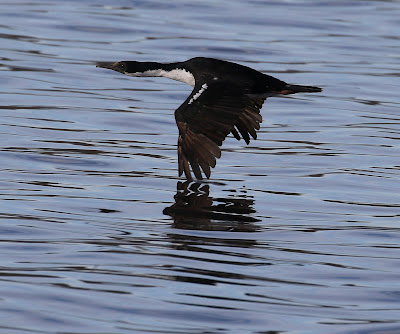In the last Post I covered the highlight of the Beagle Channel boat trip to Estancia Harberton which was seeing Blackish Cinclodes. However, the rest of the trip down to Estancia Harberton is really
good. Soon after leaving Ushuaia the boat stopped just off the first of several small rocky islands. We stopped at several islands for a few minutes & each island had a good selection of Seabirds & South American Sealions on them. It looks like most islands get at least one visit during the tourist season & the Birds didn't seem stressed by our close approach.
Black-browed Albatross
One of the small rocky islands
There was a good selection of Seabirds and other wildlife on the rocky islands.
Black-browed Albatross
Black-browed Albatross: I saw over a hundred Alberts with several large groups sitting on the water
Southern Giant Petrel: The pale greenish tip is hardly visible on this individual, but it would be a pastel-red colour in Northern Giant Petrel
Antarctic Fulmar
Antarctic Fulmar
Antarctic Fulmar: Not a hard species to pick out in the Southern Oceans for European Birders
Antarctic Fulmar
Rock Shag: Adult. A deceptive photo as it doesn't show their white belly
Rock Shag: Immature. Rock Shags are also called Magellanic Shags
Imperial Shag: This is the nominate atriceps subspecies which is found in Argentina & Chile. The other subspecies occurs on the Falklands
Imperial Shag: Showing the extent of the white on the upperwing
Imperial Shag: Showing the extent of the white on the upperwing
Imperial Shag
Flightless Steamerduck: The grey body feathers, thicker bills and obviously short wings confirms these are Flightless Steamerducks. This photo can be compared to the Flying Steamerduck photo in the On The Waterfront Post
Snowy Sheathbill: This species occurs from Southern Chile & Argentina, the Falklands & South Georgia & down to the pack ice
Flightless Steamerduck: The grey body feathers, thicker bills and obviously short wings confirms these are Flightless Steamerducks. This photo can be compared to the Flying Steamerduck photo in the On The Waterfront Post
Snowy Sheathbill: This species occurs from Southern Chile & Argentina, the Falklands & South Georgia & down to the pack ice
Rufous-chested Dotterel: Some of the 25+ roosting individuals on one of the islands
Chilean Skua
South American Tern: The common Sterna Tern in Tierra Del Fuego
South American Sealion: But it gives itself away in the next second
Argentinian mountain: I would how many pairs of White-bellied Seedsnipe there are in this photo
Argentinian mountains: The guide on the boat was saying the glaciers in the last ice age were about a km deep, resulting in the mountain tops being exposed. This explained the jagged, weathered mountain tops compared to the smoother lower tops
A Chilean Skua flies over the lower, rounded Argentinian mountain tops
Argentinian mountain
Chilean Skua
South American Tern: The common Sterna Tern in Tierra Del Fuego
South American Sealion: There was a significant number of South American Sealions on one part of the island
South American Sealion
South American Sealion: Not quite sure why all the odd head positions, but guessing it is to expose different parts of the head to the sun
South American Sealion: One of the local bulls
South American Sealion: Trying to look like a PorpoiseSouth American Sealion: But it gives itself away in the next second
Argentinian mountain: I would how many pairs of White-bellied Seedsnipe there are in this photo
Argentinian mountains: The guide on the boat was saying the glaciers in the last ice age were about a km deep, resulting in the mountain tops being exposed. This explained the jagged, weathered mountain tops compared to the smoother lower tops
A Chilean Skua flies over the lower, rounded Argentinian mountain tops
Argentinian mountain




































